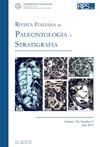Palynology and Chemostratigraphy of Middle Triassic successions in Northern Switzerland (Weiach, Benken, Leuggern) and southern Germany (Weizen, Freudenstadt)
IF 1.9
3区 地球科学
Q2 GEOLOGY
引用次数: 3
Abstract
New Anisian to Ladinian palynology, palynofacies and stable carbon isotope records are reported for the Middle Triassic from deep Swiss wells (Weiach, Benken, Leuggern), well B3/13 (Weizen, S-Germany) and the type area of the Freudenstadt Formation in southern Germany. A wide spectrum of moderately to well-preserved palynomorphs represent a high Middle Triassic plant diversity. Based on the distribution of diverse spore-pollen assemblages five Anisian Palynozones (A–E) and two Ladinian ones (F, G) are differentiated. Throughout these Palynozones the occurrence of spores and pollen, assigned to plant groups so far known only from the Palaeozoic, shed a new light on the evolution of plant assemblages during the Triassic. The comparison of Palynozones A–G with palynostratigraphic schemes from the central part of the Germanic Basin and from the Tethyan realm demonstrate the regional variability of marker species ranges – especially for the Anisian. n agreement with the lithological record, two prominent transgressive events (Lower Muschelkalk, Upper Muschelkalk) are indicated by increased abundances of marine particulate organic matter in palynofacies data. Marginal marine influence is documented at the base of the studied interval, comprising the Buntsandstein and the base of the Lower Muschelkalk. Carbonate carbon isotopes data show a negative shift at the boundary between lower and middle Muschelkalk. Coincidently, a prominent change in relative abundances of climate-sensitive plant groups (e.g. Triadispora spp. vs. Pteridophytes) indicate a change to relatively dryer climatic conditions during the middle Muschelkalk.瑞士北部(Weiach, Benken, Leuggern)和德国南部(Weizen, Freudenstadt)中三叠统的孢粉学和化学地层学
本文报道了瑞士深井(Weiach, Benken, Leuggern)、B3/13井(德国南部Weizen)和德国南部Freudenstadt组类型区中三叠统新安尼期-拉底期孢粉学、孢粉相和稳定碳同位素记录。广泛的中三叠统至保存完好的地貌代表了高的植物多样性。根据不同孢粉组合的分布,划分出5个安尼西亚孢粉带(A-E)和2个拉甸孢粉带(F, G)。在这些孢粉带中,孢子和花粉的出现为三叠纪植物组合的进化提供了新的线索,这些孢子和花粉被分配给了迄今为止只从古生代发现的植物群。将孢粉带A-G与日耳曼盆地中部和特提斯王国的孢粉地层方案进行比较,证明了标记物种范围的区域差异,特别是对于阿尼西亚。与岩性记录一致,孢粉相资料中海相颗粒有机质丰度的增加表明了两次突出的海侵事件(下Muschelkalk、上Muschelkalk)。在研究区间的底部,包括Buntsandstein和Lower Muschelkalk底部,记录了边际海洋影响。碳酸盐岩碳同位素数据显示,在Muschelkalk的中下部边界处有负移。巧合的是,气候敏感植物类群的相对丰度的显著变化(如triadiispora spp. vs. teridophytes .)表明在Muschelkalk中期气候条件相对干燥。
本文章由计算机程序翻译,如有差异,请以英文原文为准。
求助全文
约1分钟内获得全文
求助全文
来源期刊
CiteScore
3.60
自引率
4.30%
发文量
28
审稿时长
>12 weeks
期刊介绍:
The Rivista Italiana di Paleontologia e Stratigrafia was founded in 1895. It publishes original papers dealing with all fields of paleontology and of stratigraphy, from Italy and the Mediterranean to the Tethys, as well across the globe from China to North America.

 求助内容:
求助内容: 应助结果提醒方式:
应助结果提醒方式:


